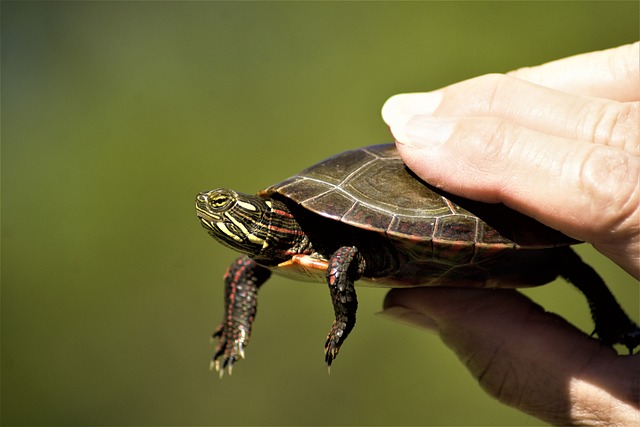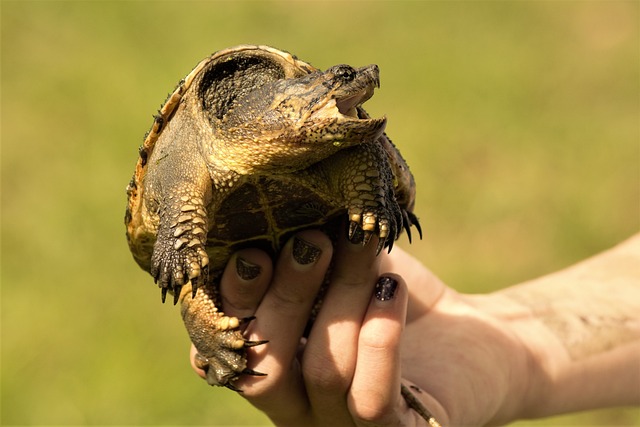- April 15 Presentation
- By Madeline Sanagan
Helping Turtles Cross the Road
Perhaps the most important take way I hope club members got from my presentation was how to safely help a turtle cross the road. It’s highly likely that many of you will encounter a turtle trying to cross the road, so knowing how to help them cross can save turtles lives!
How to help a turtle cross the road:
- If it is safe to do so, pull over and put your hazard lights on.
- Determine which direction the turtle is heading.
- Approach it from behind.
- Pick up the turtle and place it on the side of the road they were already heading towards, well into the ditch so they are far from traffic.

Painted turtles
They can be picked up like a hamburger. Just aim their rear end away from you as their primary defence is to pee with surprising force!

Snapping turtles
They can be picked up between their back legs and/or supported under their belly. They cannot hide in their shells so they will be defensive and may try to bite.
Methods include:
- Wheelbarrow (grabbing the back of their shell to lift the back legs and drag them)
- Pizza platter (using your non-dominant hand to get a secure grip around the base of their tail/back of shell, and your dominant hand to slide under the belly and lift)
- Magic carpet (scooping them onto a shovel, or dragging them on a car mat)
- Leash (getting them to bite a stick and dragging them – this will scratch their belly, but it’s better than being hit by a car! Usually this would be a last resort method)
- Some demonstrations of the above can be found in this video.
- Do not take them to a different area or wetland, this can cause death or injury. They know where they are going, trust them!
- Return to your vehicle and use sanitizer or wash your hands as soon as possible.
Injured Turtles: Call the Ontario Turtle Conservation Centre
This is a turtle hospital just outside of Peterborough. If you find an injured turtle, call them immediately at 705-741-5000 (you may have to leave a voicemail and wait for a return call). Make note of the exact location you found the turtle. Secure the turtle in a Rubbermaid bin with holes in the lid for air, and do not provide food or water. The OTCC has a network of volunteer “Turtle Taxi” drivers that can transport the turtle to the hospital, or to the nearest participating vet clinic (for us, I believe it is in Chatsworth) to provide emergency triage care and pain management until transport to the hospital is possible. If you are able to drive some of the initial route, I know they really appreciate it. Turtles are remarkably resilient and can heal from seemingly extreme injuries if given the proper care, so even if you’re not sure the turtle will survive, call anyway. At the very least they may be able to save & incubate any eggs the turtle may be carrying. When the turtle heals, they will contact you to help set up a release back where you found it originally, which can be a rewarding and special experience.
Turtle Nest Protector Box Plans
Please find attached the building plans and installation instructions we use from the Canadian Wildlife Federation. We’ve found it to be effective at preventing predators from digging up the eggs. It also doubles as a visible barrier for motorists so the nest doesn’t get run over by heavy vehicles.
IMPORTANT: You CANNOT install a nest protector box on any highway, as it is a safety issue and the MTO needs all roadsides clear for any car to pull off. You will need permission from your municipality to install nest protector boxes on the shoulders of any other public roads. Exercise good judgement when assessing how close to the road you can install a nest box – if a nest box is too close to the white line/edge of driving lane it can become more dangerous to drivers. If the nest is on private land/driveway, you just need the property owner’s permission.
Please note: it’s important to only install nest protector boxes where you are absolutely certain there is a nest. Generally, this means you actually have to see the turtle laying the eggs, wait for her to be done (which can take up to 2 hours sometimes, but a magical experience to observe!), and then install the protector box right away, or mark the nest spot somehow (with a distinctive rock, stick, flagging tape, etc) if you don’t have a next protector box with you, so you can return shortly after to install it. I would recommend keeping a nest protector box, the stakes, and a hammer in your car trunk so if you come across a nesting turtle you don’t have to leave and come back.
Some notes based on our experience building and using the protector boxes:
- The building plans suggest notching out two holes in the side of the box. To mitigate concerns of hatchlings potentially exiting the box toward the road, we only cut one hole and orient the box so the exit faces away from the road. The hatchlings have no trouble finding their way out.
- We suggest using flagging stakes (staked in the ground at the corner of the nest box) and waterproof hi-vis reflective sticker tape (on the sides of the nest box) to make it more visible during the day and night to motorists.
Reporting Deceased Reptiles (Roadkill)
There was a question about tracking reptil roadkill. I do encourage anyone to report their observations on iNaturalist. It’s a very user-friendly app that is used for all kinds of wildlife sightings. When submitting an observation, there is the option to mark the animal as “deceased”. This can be used by organizations to filter observations and see where roadkill hotspots are. At Bruce Peninsula National Park, we monitor these sightings to help us determine where an ecopassage or turtle/reptile crossing sign might be most effective. Though I’m not familiar with any specifc organizations down your way doing this currently, I would definitely still submit those sightings in case they can be used in the future.
On the Road Again
Here is more information on the Road to Recovery program that has been running at Bruce Peninsula National Park for many years now, as I discussed in the presentation on Monday.
Downloadable Resources


